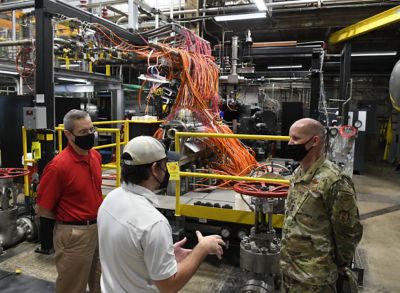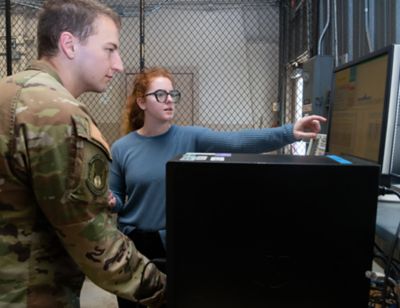ANSYS BLOG
June 12, 2023
Ansys Earns Its Wings at the Air Force Test Center
With a mission to “forge our nation’s sword and shield,” the Air Force Test Center (AFTC) bears an enormous responsibility. It conducts developmental and follow-on testing and evaluation of manned and unmanned aircraft, related avionics systems, flight controls, and munitions and weapon systems. AFTC has flight tested every aircraft in the Army Air Force’s and the United States Air Force’s inventory since World War II.
Headquartered at Edwards Air Force Base (AFB) in California, AFTC also conducts flight tests at Eglin AFB in Florida and ground tests at Arnold AFB in Tennessee. The center owns more than $31 billion in assets and employs over 18,000 military and civilian personnel — all focused on delivering critical safety and reliability evaluations for aircraft and related systems.
In addition to flight-testing and evaluating new aircraft, AFTC’s work includes testing upgrades to aircraft already owned by the U.S. Air Force, the Department of Defense (DoD), the National Aeronautics and Space Administration (NASA), and other government agencies. Typical AFTC projects are aimed at assessing proposed improvements to radar, weapons-delivery, and navigation systems, along with their underlying software.
Top-Tier Testing Requires Top-Tier Resources
Because it’s imperative that AFTC’s test programs are as thorough as possible, with a high degree of scientific rigor, the center operates some of the world’s most advanced physical testing facilities. It owns nearly 70 aerodynamic and propulsion wind tunnels, rocket and turbine engine test cells, environmental chambers, ballistic ranges, and an over-water test range in Florida that spans 120,000 square miles. AFTC augments these assets with advanced technologies in engineering and design so that its personnel are equipped with tools that meet their mission.
“If we don’t help with the pathfinding for digital materiel management, the Air Force will lag. The Test Enterprise is foundational for capability development and ensuring credible capability is rapidly delivered to the warfighter,” says Maj. Gen. Evan Dertien, AFTC commander.
“Our ability to collaborate digitally with other AFMC Centers like AFRL, LCMC, and AFSC and partners like the AF Warfare Center, AFOTEC, and industry is critical to future mission success. If we’re going to rapidly integrate new capabilities to be competitive in a peer environment, we need a digital environment that can leverage new tools and enhance collaboration.”
AFTC’s advanced engineering tool kit includes Ansys engineering simulation software. By applying Ansys simulations at an early stage of testing design to replicate physical trial conditions, AFTC can identify areas of interest — whether a specific aircraft component or a real-world operating parameter — to ensure that its physical tests are focused and efficient. While there’s no substitute for physical testing when so much is at stake, AFTC uses simulation to make that testing smarter and faster.
“When we align personnel and assets from around the country with the permissions in place to go fly, we need to make it score for count! We need to gather as many viable test points for both developmental and operational flight testing and share that data with any future projects with those associated systems,” says Christopher Hereford, the AFTC digital engineering lead.

John Hile, center, an Arnold Engineering Development Complex (AEDC) test engineer, speaks with Maj. Gen. Evan Dertien, commander, Air Force Test Center, about the use of arc heaters, such as the one seen in the background, for characterizing and evaluating thermal protection systems. Also pictured is Frank Wonder, arcs capability manager. U.S. Air Force photo by Jill Pickett.
Minimizing Uncertainty, While Maximizing Testing Effectiveness
When AFTC receives a new aircraft or system from a supplier, it first conducts uncertainty modeling. Based on the supplier proposal, AFTC needs to ensure that the physical design will deliver the promised performance. Because it’s impossible to exhaustively test every system and every component under every possible operating parameter, AFTC relies on preliminary Ansys simulations to narrow the field and identify the areas of greatest risk.
For example, the engineering team at Arnold AFB uses Ansys Fluent and Ansys optiSLang to create a virtual model of a product system — whether a scale aircraft model or a component such as a wing — and a virtual model of a wind tunnel. By running its planned tests in a virtual landscape, AFTC can predict the likely results of those tests at a very early stage. Out of hundreds of variables that might impact the success of a mission, Ansys simulation studies can narrow the areas of potential interest down to tens of variables — leading to refined wind-tunnel studies and more insightful test results.
Ansys software is also helping AFTC design more intelligent tests that reveal critical performance factors as quickly and cost-effectively as possible. Ansys STK is ideally suited to this task, since it enables engineers to model complex systems inside a realistic, time-dynamic 3D simulation environment that includes high-resolution terrain, imagery, and radio frequency (RF) characteristics. AFTC engineers can create precise models of ground, sea, and air assets and then insert moving product systems into this virtual landscape.
Ansys Test and Evaluation Tool Kit (TETK), an extension of STK, improves the efficiency and effectiveness of test and evaluation activities across the digital engineering product life cycle.
For example, the test design team at Eglin AFB uses TETK to plan its aircraft testing routes over open water. When AFTC launches an F-16 over the Gulf of Mexico and has it perform maneuvers such as roll-overs to ensure that its new communications systems work properly, that’s a very time- and cost-intensive endeavor — as much as $100,000 per hour. Ansys TETK helps sharpen the focus and limit the number of real-world maneuvers that are required. Test pilots can focus on critical flight parameters — using a smaller set of aerial exercises — with the insights provided by TETK. And, TETK also helps resolve anomalies by ingesting actual flight data and enabling post-flight analysis.
“The Gulf of Mexico is an invaluable asset to the Eglin Test team because it represents an over-the-water range to conduct high-risk or long-range weapons’ tests,” says Dr. Elisabetta Jerome, AFTC technical advisor for armament and weapons test and evaluation. “To do so in the most efficient and safe way, we must have a network of instrumentation, real-time data acquisition and AI-supported data analyses.”

Nicole Prieto, a test manager with the 717th Test Squadron (717 TS), 804th Test Group, Arnold Engineering Development Complex, and 2nd Lt. Paul McCormack, a test engineer with the 717 TS, look at data from a non-interference stress measurement system training environment in the Innovation Center at Arnold Air Force Base. U.S. Air Force photo by Jill Pickett.
A Case in Point: Characterizing the Performance of an IRST
Recently, the AFTC team at Edwards AFB used Ansys Fluent, Ansys Mechanical, and Ansys Speos to solve a complex multiphysics problem centered around an infrared sense-and-track (IRST) system mounted under a plane’s wing. IRSTs include optical sensors that enable pilots to see objects on their dashboard displays, then launch a rapid, effective air-to-air or air-to-ground strike.
Obviously, there’s no room for error when weapons are being deployed. But, ensuring that an IRST will deliver accurate images poses an intricate challenge on an aircraft traveling at Mach 1, in all kinds of atmospheric conditions, with the sensor assembly strained by physical forces and thermal gradients. Deformation of the sensing window is a special concern, because it can lead to distorted images and inaccurate targets.
Test practitioners at AFTC are creating detailed models of the sensor in Speos and Mechanical, then using Fluent to simulate thermal and aerodynamic forces on them. AFTC engineers can study how the sensor is affected by natural forces — such as clouds, air temperature, the speed and altitude of the plane, and the speed and altitude of the target — without ever launching an aircraft. While physical flight testing is still required, these multiphysics studies are helping to identify potential failure modes for the IRST, which can then be carefully studied in the air.
AFTC Feels the Need for Speed — And Ansys Delivers
According to Dr. Eileen Bjorkman, AFTC executive director, one of the biggest challenges for AFTC is rapidly validating innovative new systems that can strengthen U.S. defense while ensuring that rigorous testing and verification have been conducted for each of these systems.
“Advanced modeling and simulation techniques are the key to developing and fielding systems faster, but also for making rapid changes to those systems after they’re fielded to keep up with an evolving threat,” she says. “If we have a digital environment and high-fidelity model of the system, designers can start modifying the system as soon as operators detect the need for change. At the same time, AFTC engineers and pilots can jump into the digital environment to start evaluating the proposed changes, and they can start planning for live testing if needed to resolve issues that can’t be fully explored in the simulated environment. The goal is an end-to-end modification process that can be completed in days or weeks, or even a few hours, instead of months or years.”
By enabling AFTC engineers to arrive at preliminary findings in a low-cost virtual testing environment, Ansys solutions are accelerating the deployment of new aircraft and systems. As the U.S. military targets groundbreaking technology improvements that safeguard lives and improve defense capabilities, digital engineering has earned its wings by speeding up this process, while also reducing costs.